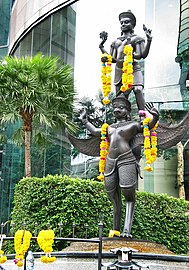Narayana
| Narayana | |
|---|---|
Protector of the Worlds Bhudevi, and Niladevi |
| Part of a series on |
| Vaishnavism |
|---|
 |
Narayana (
Etymology
Narayan Aiyangar states the meaning of the Sanskrit word 'Narayana' can be traced back to the Laws of Manu (also known as the Manusmriti, a Dharmaśāstra text),[8] which states:
The waters are called narah, (for) the waters are, indeed, the offspring of Nara; as they were his first residence (ayana), he thence is named Narayana.
— Chapter 1, Verse 10[9]
This definition is used throughout post-Vedic literature such as the Mahabharata and the Vishnu Purana.[10][8] 'Narayana' is also defined as the 'son of the primeval man',[11] and 'Supreme Being who is the foundation of all men'.[12]
- 'Nara' (Sanskrit नार) means 'water' and 'man'[13]
- 'Yana' (Sanskrit यान) means 'vehicle', 'vessel', or more loosely, 'abode' or 'home'[14]
L. B. Keny proposes that Narayana was associated with the
Description
In the Vedas and the Puranas, Narayana is described as having the divine blackish-blue color of water-filled clouds, four-armed, holding a Padma (lotus), Kaumodaki (mace), Panchajanya shankha (conch), and the Sudarshana Chakra (discus).
Hinduism
As stated in the epic Itihāsa, the Mahabharata:
I am Narayana, the Source of all things, the Eternal, the Unchangeable. I am the Creator of all things, and the Destroyer also of all. I am
Kasyapathe lord of the created things. And, O best of regenerate ones, I am he called Dhatri, and he also that is called Vidhatri, and I am Sacrifice embodied. Fire is my mouth, the earth my feet, and the Sun and the Moon are my eyes; the Heaven is the crown of my head, the firmament and the cardinal points are my ears; the waters are born of my sweat. Space with the cardinal points are my body, and the Air is my mind...
...And, O Brahmana, whatever is obtained by men by the practice of truth, charity, ascetic austerities, and peace and harmlessness towards all creatures, and such other handsome deeds, is obtained because of my arrangements. Governed by my ordinance, men wander within my body, their senses overwhelmed by me. They move not according to their will but as they are moved by me.— Mahabharata (translated by Kisari Mohan Ganguli, 1883-1896), Book 3, Varna Parva, Chapter CLXXXVIII (188)[10]
As per texts like the Vishnu Purana, Bhagavata Purana, Garuda Purana, and the Padma Purana, Narayana is Vishnu himself, who incarnates in various avatars.
According to the
According to the
According to
Narayana is also described in the Bhagavad Gita as having a universal form (Vishvarupa) which is beyond the ordinary limits of human perception or imagination.[21]
In the Narayana Sukta, Narayana is essentially the supreme force and/or essence of all: 'Nārāyaṇa parabrahman tatvam Nārāyaṇa paraha'.[22]
Narayana's eternal and supreme abode beyond the material universe is
The Śruti texts mention Narayana as the primordial being who was present even when Brahma and Ishana (Shiva) were not present. He is conceived as the Supreme Soul in the texts.[25]
Buddhism
The Mahāsamaya Sutta (DN 20) of the
The
He appears as an
He is also mentioned in several places in the
The
Jainism
This section needs additional citations for verification. (May 2023) |
Balabhadra and Narayana are mighty half-brothers, who appear nine times in each half of the time cycles of the Jain cosmology and jointly rule half the earth as half-chakravarti. Ultimately Prati-naryana is killed by Narayana for his unrighteousness and immorality. Narayana are extremely powerful and are as powerful as 2 Balabhadras. Chakravartins are as powerful as 2 Narayanas. Hence Narayanas become half-chakravartins. Tirthankaras are much more powerful than Chakravartins. In Jain Mahabharata, there is a friendly duel between cousin brothers Neminatha (Tirthankara) and Krishna (Naryana) in which Neminath defeats Krishna without any effort at all. There is also a story of Neminatha lifting the conch of Krishna and blowing it without any effort. In the Jain Mahabharata, the conflict between Krishna and Jarasandha is described, who is killed by Krishna.
Literature
Narayana is hailed in certain parts of the Vedas like the Narayana Suktam and the Vishnu Suktam. He is also hailed in selective Vaishnava Upanishads like the Narayana Upanishad, Mahanarayana Upanishad, and the Nrisimha Tapaniya Upanishad.[31]
The Padma Purana relates an episode where Narayana grants Rudra (Shiva) a boon. The destroyer deity seeks two boons. Firstly, he wishes to be the greatest of the devotees of Narayana, as well as bearing the reputation of the same throughout the world. Secondly, he desires the ability to offer salvation to whoever seeks refuge in him.[32]
The prowess of Narayana is described in the Ramayana:[33]
Narayana, like unto a luminous cloud, with his excellent shafts loosed from His bow, as so many lightning strokes, exterminated those rangers of the night with their hair dishevelled and streaming in the wind. Their parasols broken, their rich apparel torn by the shafts, their entrails ripped open, their eyes wide with fear, those warriors, throwing away their arms, fell into a frenzy of terror. Resembling elephants attacked by a lion, those night-rangers with their mounts emitted cries whilst fleeing from that Primeval Lion [i.e., Vishnu’s incarnation as Nrsimha—half man, half lion], who pursued them.
Ramanuja's prayer of surrender to Narayana in the Sharanagati Gadyam of the Tiruvaymoli was and is significant to his Sri Vaishnava adherents, as it became a model prayer for future generations. In this prayer, Ramanuja describes Narayana to be the "beloved consort of Sri and of Bhumi and Nila". He is stated to reside in his abode of Vaikuntha, where he assumes the role of the creation, preservation, as well as the destruction of the universe. Narayana is extolled to be the same as the Ultimate Reality, Brahman. He is regarded to be the refuge of all creation, the master of spiritual as well as material entities, as well as the dispeller of the miseries of his devotees. He ends his prayer by saluting Narayana and his consort Sri, to whom he surrenders to his "lotus-like feet".[34]
-
Narayan Temple on Narayanhiti palace premises, Kathmandu, Nepal
-
Oldest Sridhar Narayan statue at Naksaal, Kathmandu
-
The bow ofRama IX of Thailand, it carved an image of Narayana riding a Garuda
-
Sculpture of Narayana around 14/15th century, found at the Devasathan, inner Bangkok, Thailand
-
Sculpture of Narayana ride a Garuda built in Khmer art style in front of InterContinental Bangkok, Phloen Chit Road, it is one of the most respected Hindu shrines in the Ratchaprasong neighbourhood alike Erawan Shrine
-
Drawing of sleeping Narayana onSheshanaga while the four-headed Brahmasprings from his navel
-
Statue of Narayana in Thai art style stands on Mount Mandara within Suvarnabhumi Airport, Samut Prakan, Thailand
-
Khmer lintel depicting Narayana sleeping upon the Sheshanaga in the middle ofMilky Ocean, Bangkok National Museum
See also
- Adam Kadmon
- Bhagavan
- Bhakti
- Garbhodaksayi Vishnu
- Hari
- Hiranyagarbha
- Jagannath
- Kshirodakasayi Vishnu
- Mahavishnu
- Narayana sukta
- Pangu
- Parabrahman
- Paramatma
- Pausha
- Ranganatha
- Sankarshana
- Vaikunta
- Vishnu
- World egg
- Salakapurusa
| Vyūhas | Image | Attributes | Symbol[38][39] | Direction | Face | Concept | |||
|---|---|---|---|---|---|---|---|---|---|
| Narayana Vishnu |
Vāsudeva | Chakra Wheel Gadā Mace Shankha Conch |
Garuda Eagle | 
|
East | Saumya (Placid/ benevolent) |
Jṅāna Knowledge | ||
Samkarsana
|
Lāṅgala Pestle Wine glass |
Tala Fan palm | 
|
South | Simha Lion | Bala Strength | |||
| Pradyumna | Cāpa Bow Bāṇa Arrow
|
Makara Crocodile | West | Raudra Kapila | 
|
Aiśvaryā Sovereignty | |||
| Aniruddha | Carma Shield Khaḍga Sword |
Ṛṣya (ऋष्य) White-footed antelope | North | Varaha Boar | Śakti Power | ||||
References
- ^ "Invoking Auspiciousness [Chapter 1]". 14 August 2014.
- ^ "Narayana, Nārāyaṇa, Nārāyana, Narāyana, Nara-ayana, Nara-yana: 40 definitions". June 2008.
- ISBN 978-0-19-028888-4.
- ISBN 9788120832695.
- ISBN 9780227900352.
- ISBN 9780791403648.
- ISBN 9781136851858.
- ^ a b Narayan Aiyangar (1901). Essays on Indo Aryan Mythology. pp. 196.
- ^ "The Laws of Manu I". www.sacred-texts.com. Retrieved 7 December 2019.
- ^ a b "The Mahabharata, Book 3: Vana Parva: Markandeya-Samasya Parva: Section CLXXXVIII". www.sacred-texts.com. Retrieved 5 December 2019.
- ^ "Monier-Williams Sanskrit-English Dictionary -- n". faculty.washington.edu. Archived from the original on 7 May 2020. Retrieved 5 December 2019.
- ISBN 0-19-280271-2, page 11
- ^ "Sanskrit Dictionary for Spoken Sanskrit: 'nara'". spokensanskrit.org. Retrieved 5 December 2019.
- ^ "Sanskrit Dictionary for Spoken Sanskrit 'yana'". spokensanskrit.org. Retrieved 5 December 2019.
- ISBN 978-0-88920-743-1.
- ISBN 978-93-5305-362-8.
- ISBN 978-0-14-306762-7.
- ISSN 1756-4255.
- ^ Vaisnavism Saivism and Minor Religious Systems, Ramkrishna Gopal Bhandarkar. Published by Asian Educational Services, p.46.
- ISBN 0-7914-0249-5. p61
- Prabhupada, AC Bhaktivedanta. "Bhagavad-gita As It Is Chapter 11 Verse 3". vedabase.net. Archived from the originalon 15 May 2008. Retrieved 10 May 2008. "see the cosmic manifestation"
- ^ "॥ नारायणसूक्तम् सार्थ ॥ - .. Narayana Sukta .. - Sanskrit Documents". sanskritdocuments.org. Retrieved 21 October 2015.
- ^ "Sapthagiri". Archived from the original on 15 May 2007. Retrieved 21 May 2007.
- ISBN 978-1-4053-3648-2.
- ^ "Upanishads".
- ^ "SN 2.12: With Vishnu —Bhikkhu Sujato". SuttaCentral. Retrieved 25 December 2019.
- ^ "那羅延". Digital Dictionary of Buddhism. 2009. Retrieved 25 December 2019.
- ^ Giebel, Rolf W. (translator) (2005). The Vairocanābhisaṃbodhi Sūtra (PDF). BDK America, Inc.
{{cite book}}:|first1=has generic name (help) - ^ Roberts, Peter Alan; Tulku Yeshi (2013). "The Basket's Display". 84000: Translating the Words of the Buddha. Retrieved 25 December 2019.
- ISSN 2077-1444.
- ^ "Narayanastra – Defending Vaishnavism as the supreme Vedic position". narayanastra.blogspot.in. Retrieved 21 October 2015.
- ^ www.wisdomlib.org (26 September 2019). "Nārāyaṇa Grants Boons to Rudra [Chapter 2]". www.wisdomlib.org. Retrieved 12 August 2022.
- ^ www.wisdomlib.org (27 September 2020). "The Combat between Vishnu and the Rakshasas [Chapter 7]". www.wisdomlib.org. Retrieved 12 August 2022.
- ^ Makarand Joshi. The Tamil Veda Pillan Interpretation Of Tiruvaymoli J Carman And V Narayanan 1989 OCR.
- ISBN 978-90-04-10789-2.
- ^ A Comprehensive History of India: pt. 1-2. A.D. 300-985. Orient Longmans. 1982. p. 866.
- ISBN 978-2-84050-464-1.
- ^ "A shrine of Aniruddha, the fourth of the 'vyuhas', which had within its precincts a 'rsyadhvaja', i. e. a column bearing on its top the figure of a 'rsya' or a white antelope which was his characteristic 'lanchana'." in Journal of the Indian Society of Oriental Art. Indian Society of Oriental Art. 1937. p. 16.
- ^ Gupta, Vinay K. "Vrishnis in Ancient Literature and Art". Indology's Pulse Arts in Context, Doris Meth Srinivasan Festschrift Volume, Eds. Corinna Wessels Mevissen and Gerd Mevissen with Assistance of Vinay Kumar Gupta: 80–81.










